PREVIOUS
Supreme Court Verdict on Article 370 – Part 3
March 29 , 2024
657 days
2390
0
(இதன் தமிழ் வடிவத்திற்கு இங்கே சொடுக்கவும்)
Supreme Court Verdict on Article 370
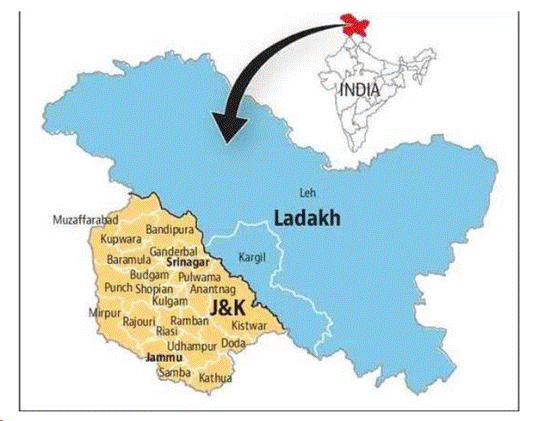
Improved Economic Development
- The government has implemented several initiatives to boost the economic development in Jammu and Kashmir, such as the Prime Minister's Development Package (PMDP) and the Industrial Development Scheme (IDS).
- These initiatives have led to increased investment, job creation, and economic growth in the region.
- This UT witnessed tax revenue growth of 31% in recent times.
- During 2022-23, the GSDP of J&K grew at 8% at constant prices, as against 7% at the national level.
Enhanced Infrastructure
- The government has also invested heavily in infrastructure development in Jammu and Kashmir.
- This includes projects such as the construction of new roads, bridges, tunnels, and power lines.
- These improvements have made it easier for people to travel and do business within the region.
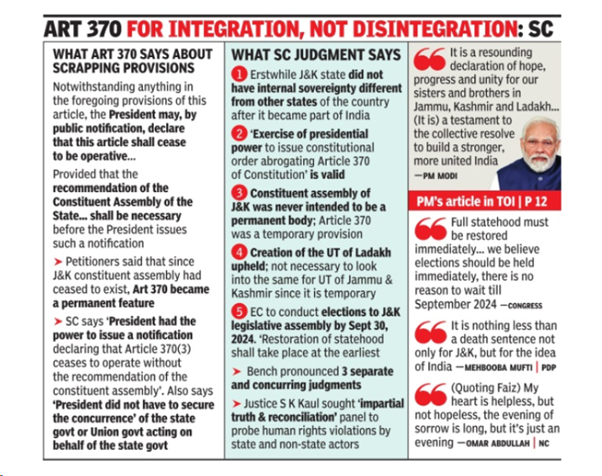
Increased Tourism
- The number of tourists visiting Jammu and Kashmir has increased significantly since the abrogation of Article 370.
- This is due to a combination of factors, including improved security, better marketing, and the launch of new tourism initiatives.
- According to a report, the region of Jammu and Kashmir has seen 1.62 crore tourists in 2022, the highest in India's 75 years of independence.
The key takeaways from the Supreme Court verdict
Nature of Article 370
- The court ruled that Article 370 was always meant to be a temporary provision, considering its historical context, wording and placement in the Constitution under part XXI.
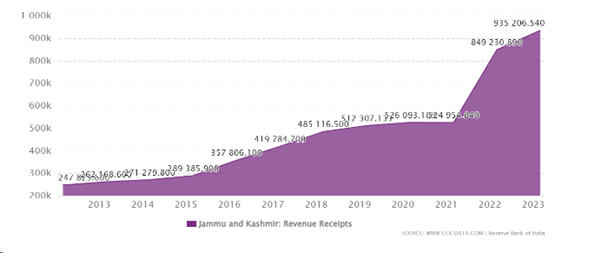
Internal Sovereignty of J&K
- The court said that J&K didn't have any internal sovereignty following the proclamation of Karan Singh (the ruler of J&K) made in 1949.
- The Proclamation stipulated that the Indian Constitution would govern the relationship between J&K and the Union.
- It had the effect of a ‘merger’ like any other princely state.
- However, one of the judges has followed the decision of the 1959 judgement in Prem Nath Kaul v Jammu and Kashmir.
- In 1959 judgement, it was held that the State retained an element of internal sovereignty.
Federalism
- Article 370 was a feature of asymmetric federalism.
- The special status granted to J&K was simply a higher degree of that autonomy, not a different kind of autonomy.
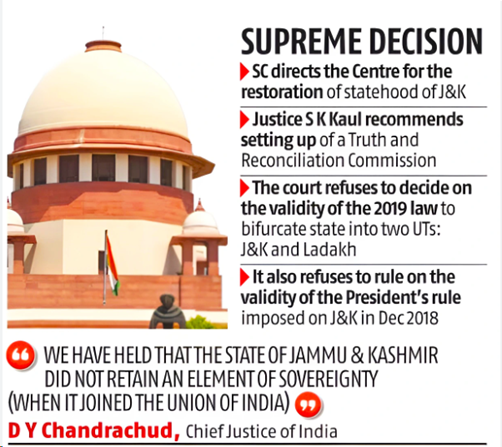
Constitution of J&K
- The Constitution of J&K was always subordinate to the Constitution of India.
- Hence, Article 370 became inoperative after the Constitutional Orders 272 and 273.
President rule in J&K
- The Supreme court upheld the validity of the President's rule in J&K.
- It said that the actions taken by the President were not irrational referring to the landmark 1994 ruling in ‘SR Bommai v. Union of India’.
- The President can assume “all or any” roles of the State legislature and such action must be tested judicially only in extraordinary cases.
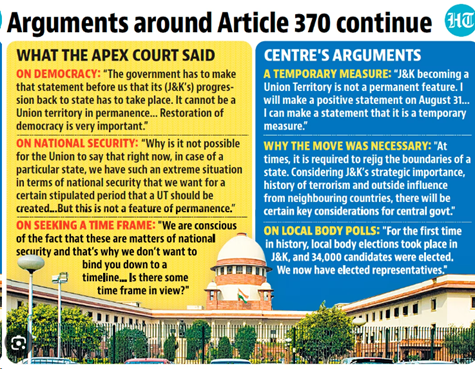
Parliament power under Article 356
- Article 356(1)(a) states that the President may declare that the “powers of the State Legislature” shall be exercised by or under the authority of Parliament.
- The court held that allowing Parliament to exercise all constitutional powers of the Legislative Assembly would limit the power of the State.
- However, the Constitution recognises such reduction of federal power when Article 356 is in force.
Reorganisation of the State under Article 3
- The court held that the Parliament has the power to reorganise J&K into 2 Union Territories under Article 3.
- It also said that the consent of the State legislature was not required as the Parliament had assumed its role during President’s Rule.
- It also asked the Union to restore statehood at the earliest.
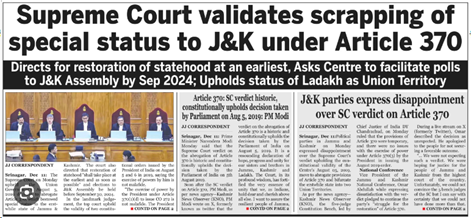
Truth and Reconciliation Commission (TRC)
- The court recommended the constitution of TRC just like South Africa did in its post-apartheid era to address human rights violations perpetrated in J&K both by State and non-State actors since the 1980s.
Elections
- The court asked the Election Commission of India to conduct elections to the J&K Legislative Assembly by 30th September 2024.
Way Forward
- A 10-year strategy for 3Es (education, employment and employability) should be deployed for uplifting Kashmir.
- The plan for a ‘zero-terror incident’ in J&K has been in force since 2020 and will be successful by 2026.
- The Gandhian path of non-violence and peace should be adopted to solve the legitimacy crisis in Kashmir.
- The government can mitigate the challenges emanating out of Action on article 370 by launching a comprehensive outreach programme to all Kashmiris.
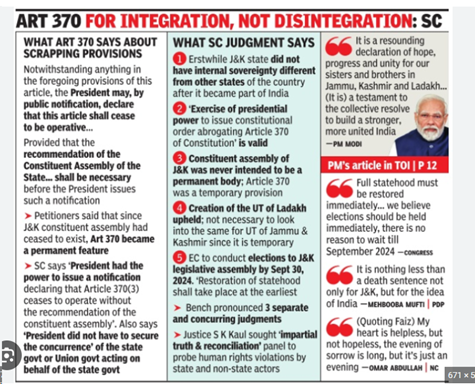
- In this context, Atal Bihari Vajpayee's version of Kashmiriyat, Insaniyat, and Jamhooriyat (inclusivity culture of Kashmir, humanitarianism and democracy) for Kashmir solution, should become a cornerstone of the forces of reconciliation in the State.
- The recent judgment by the Supreme Court has upheld the principles of 'Ek Bharat, Shreshtha Bharat'.
- It has also served as a powerful reminder of the importance of unity and a collective dedication to good governance.
- This decision showcases the court's commitment to strengthening the fabric of our nation and reinforcing the values that define us as a society.
The Jammu and Kashmir Reorganisation (Amendment) Bill, 2023

- The Jammu and Kashmir Reorganisation (Amendment) Bill, 2023 was introduced in Lok Sabha on July 26, 2023.
- The Bill amends the Jammu and Kashmir Reorganisation Act, 2019.
- The Act provides for the reorganisation of the state of Jammu and Kashmir into the union territories of Jammu and Kashmir (with legislature) and Ladakh (without legislature).
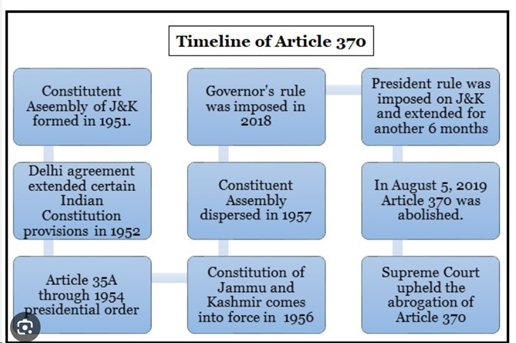
Number of seats in the Legislative Assembly
- The Second Schedule of the Representation of the People Act, 1950 provides for the number of seats in legislative assemblies.
- The 2019 Act amended the Second Schedule of the 1950 Act to specify the total number of seats in the Jammu and Kashmir Legislative Assembly to be 83.
- The Bill increases the total number of seats to 90.
- It also reserves seven seats for Scheduled Castes and nine seats for Scheduled Tribes.
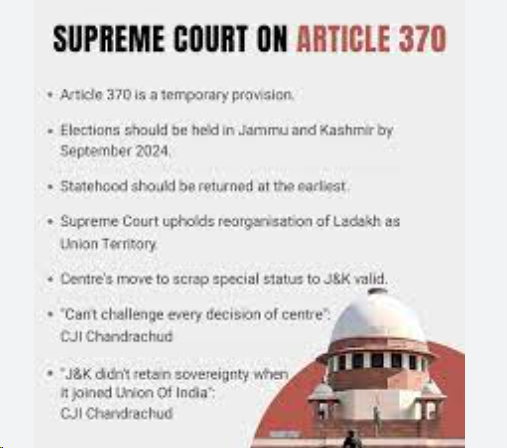
Nomination of Kashmiri migrants
- The Bill adds that the Lieutenant Governor may nominate up to two members from the Kashmiri migrant community to the Legislative Assembly.
- One of the nominated members must be a woman.
- Migrants are defined as persons who migrated from the Kashmir Valley or any other part of the state of Jammu and Kashmir after November 1, 1989, and are registered with the Relief Commissioner.
- Migrants also include individuals who have not been registered due to:
(i) being in government service in any moving office,
(ii) having left for work, or
(iii) Possessing immovable property at the place from where they migrated but are unable to reside there due to disturbed conditions.
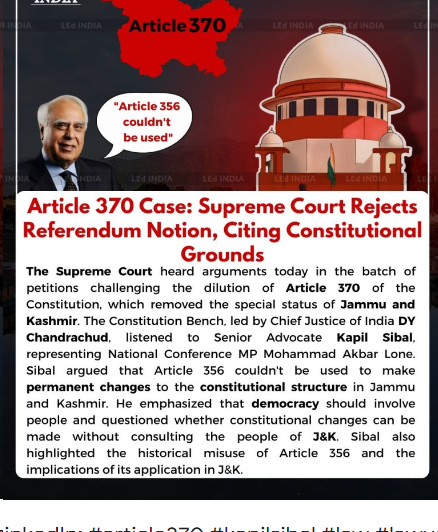
Nomination of displaced persons
- The Bill adds that the Lieutenant Governor may nominate to the Legislative Assembly one member representing displaced persons from Pakistan-occupied Jammu and Kashmir.
- Displaced persons refer to individuals who left or were displaced from their place of residence in Pakistani-occupied Jammu and Kashmir and continue to reside outside such place.
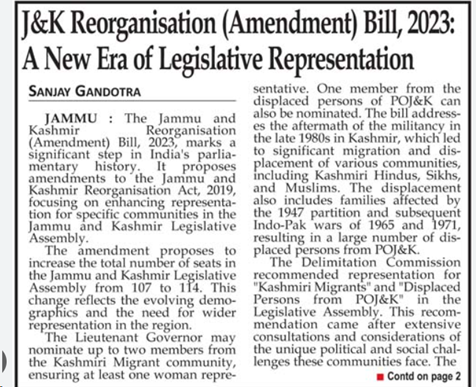
- Such displacement should have taken place in 1947-48, 1965, or 1971 due to civil disturbances or fear of such disturbances.
- These include successors-in-interest of such persons.
- The Bill seeks to represent those who became refugees in their own country and also reserves one seat in the Jammu and Kashmir Assembly for people who have been displaced from Pakistan-occupied Kashmir (PoK).
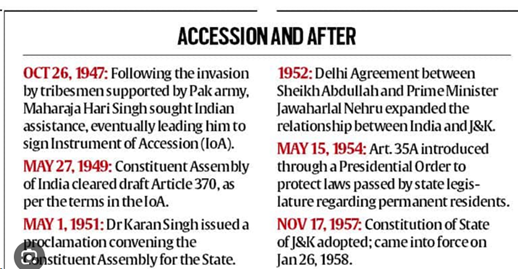
The Background
- Before the Revocation of Article 370, Jammu and Kashmir had distinct rules for delimiting Lok Sabha and Assembly seats.
- Post the abrogation of Article 370 and the region's transition into a Union Territory, a Delimitation Commission was formed in March 2020.
- This commission was tasked not only with delimiting J&K’s seats but also those of Assam, Manipur, Arunachal Pradesh, and Nagaland.
- It is aiming to finish within a year.
- Recently, the commission concluded its delimitation process.
- It is resulting in an increase in J&K's legislative assembly seats from 107 to 114.
- It is facilitated by the Jammu and Kashmir Reorganisation (Amendment) Bill, 2023.
Two Bills
- It seeks to amend Section 2 of the Jammu and Kashmir Reservation Act, 2004.
- The Jammu and Kashmir Reservation Act, 2004 provided reservation in jobs and admission in professional institutions to Scheduled Castes (SCs), Scheduled Tribes (STs), and other socially and educationally backward classes.
- The amendment Bill suggests a change in the nomenclature of a section of people who were earlier described as “weak and underprivileged classes (social castes)" to "other backward classes”.
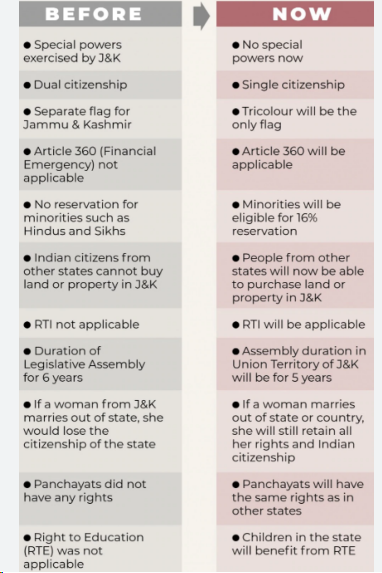
-------------------------------------
Leave a Reply
Your Comment is awaiting moderation.


